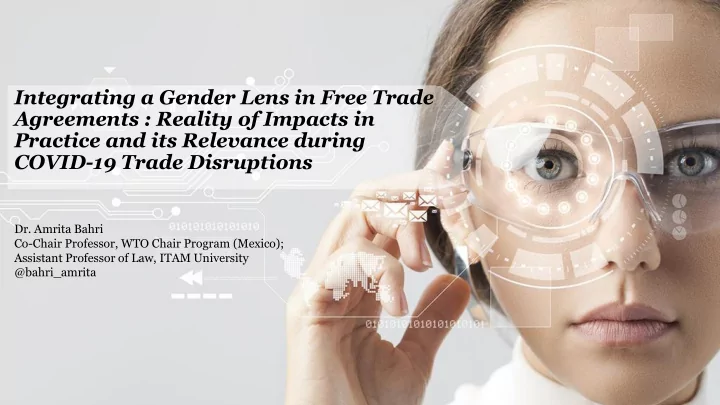

Integrating a Gender Lens in Free Trade Agreements : Reality of Impacts in Practice and its Relevance during COVID-19 Trade Disruptions Dr. Amrita Bahri Co-Chair Professor, WTO Chair Program (Mexico); Assistant Professor of Law, ITAM University @bahri_amrita
Table of Contents 1. Approach? - Measuring Gender- Responsiveness in FTAs through ITC’s Maturity Framework 2. Results? - Canada and East Africa are Pioneers, EU Follows… 3. What Next? - Preparing FTAs to Better Respond to COVID-19: 8 Policy Recommendations 2
1. Approach: Measuring Gender- Responsiveness of FTAs: ITC’s Maturity Framework Category Definition Dimensions 1. Frequency of Relevant 2. Location of Relevant Provisions Provisions This category reflects parties’ awareness and the importance they assign Awareness to the incorporation of gender concerns in the given free trade agreement (FTA). 3. Affirmations and Reaffirmations 5. Institutional 4. Cooperation Activities Arrangement Affirmative This category reflects whether parties to the given FTA consider or Action commit to any affirmative action to incorporate gender concerns. 6. Procedural 7. Review and Funding Arrangements 9. Minimum Legal 8. Settlement of Standards Disputes This category reflects whether parties to the given FTA consider or Enforcement commit to the robust enforcement of gender-components included in the FTA. 10. Waivers, Reservations & Exceptions Limited - FTA at this level is either completely Evolving - FTA at this level employs some best Advanced - FTA at this level achieves the highest level of or close to being gender-blind or gender-neutral in practices for mainstreaming gender concerns, but it has a maturity in the way it mainstreams gender concerns with the use nature as it fails to mainstream gender concerns. significant scope for further improvement . of best practices for incorporating gender concerns, and there is no or only a negligible scope for further improvement. 3
2. Results: Canada and East Africa are Pioneers, EU Follows… EU-Central America: political dialogue, protect the lives of women in conflict and violence, access to health European Economic Area: equal pay for equal work (minimum legal standard) [Mostly Non-Binding, No Finance, No Institutions or Procedures] Canada-Israel & Canada-Chile : CSR, Access to STEM and ICT education, Gender Committee, Promote women entrepreneurship SADC: women in decision-making; USMCA: Reservation for indigenous AfCFTA: gender in preamble, financing women (service), protection of gender commitments, export-capacity women employees of women-owned SMEs; [Mostly Non-Binding, No Finance] EAC: gender balance in legislative assembly [Mostly Binding, No Finance, No Institutions or Procedures] Low High Note: Gender responsiveness of each country calculated by aggregating the responsiveness scores for each FTA signed by the country div ided by the number of FTAs it has signed. FTA’s 4 text accessed at WTO RTA Database
3. What Next? Preparing FTAs to Reboot Inclusive Economy post-COVID-19 Create Institutions, Procedures and Craft a Gender-Explicit Exception Financing Channels to Ensure 8 7 Implementation Cooperate on Enhancing Enforce Commitments with Women’s Access to Education 1 6 Dispute Settlement Mechanism and Remedies Policy Recommendations 2 5 Cooperate on Enhancing Encourage Gender-Specific Women’s Access to Health Corporate Social Responsibilities 3 4 Engage Women in Trade Policy-Making Include Minimum Legal Standards 5
Three big questions: Many new FTAs (such as USMCA) contain highly enforceable labor commitments. If this can be negotiated, why countries are still reluctant to 1 include enforceable gender-related commitments such as equal pay for equal work? If we can have exceptions to protect public morals, or animal health or life, or 2 even plant health or life in almost 100% of existing FTAs, why can’t we negotiate an exception to reduce gender inequality? Even if gender provisions are not made enforceable, wouldn’t they remain a 3 distant reality if parties do not craft procedures and institutions or mobilize funds to put these commitments to action? 6
¡Thanks! Dr. Amrita Bahri @bahri_amrita Amrita.bahri@itam.mx
Recommend
More recommend